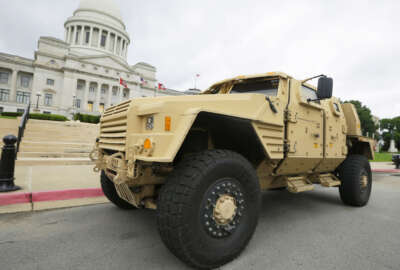
Defense companies getting skittish over shutdown, sequestration
Defense and aerospace companies are calling on Congress to come to a decision to avert budget cuts.
As the clock continues to tick down to a possible government shutdown by the end of Friday, with no budget deal to raise budget caps in sight, defense companies are starting to squirm under the pressure.
More than 40 leaders in the defense and aerospace industry sent a letter to Congress urging them to avert letting the budget fall to sequestration levels for the first time since 2013. The letter was curated by the Aerospace Industries Association.
“We remain concerned that final FY 18 appropriations, without repeal or substantial alteration of the discretionary spending caps introduced by the Budget Control Act of 2011, could undermine our collective commitment to strengthening military readiness,” stated the Dec. 1 letter, which was signed by companies such as Lockheed Martin, General Dynamics, Northrop Grumman and Honeywell.
The letter tried to tug at the heartstrings of domestic spending advocates as well. The letter noted critical nondefense programs also benefit from stable and timely funding.
“The Federal Aviation Administration, for instance, is responsible for approving new aircraft technologies that help our manufacturers and innovators compete in a growing worldwide market for commercial and general aviation aircraft. The National Aeronautics and Space Administration maintains and enhances our global leadership through initiatives in science, exploration and aerospace technology. These non-defense programs are vital to our economic prosperity and to our ability to maintain a vibrant and robust aerospace and defense industrial base,” the letter stated.
The letter writers hope Congress can come to a budget deal to avert a shutdown and raise the budget caps.
“At the heart of AIA’s mission is to advocate for policies and responsible budgets that keep our country strong, bolster our capacity to innovate, and spur American economic growth,” said AIA President and CEO David F. Melcher. “Budget stability unlocks all of those. This letter is another example of the continuing leadership role AIA plays in shaping an environment where the nation is secure and prosperous and where American industry and innovation thrives.”
It’s worth noting many of the companies rely on funding and contracts from the government. Still, the top 100 aerospace and defense companies reported $709 billion in revenue in 2016, which resulted in almost $70 billion in profits.
Those numbers have prompted some DoD policymakers to demand industry take on more of a financial burden when it comes to things like research and development.
In 2015, Frank Kendall, DoD’s then-undersecretary of acquisition, technology and logistics, said he “would like industry to make greater investments” in innovation.
If the government shuts down, it will be unable to pay installments on its contracts. It will also not be able to start any new programs, but the government is unable to do that currently, since it’s under a continuing resolution.
Defense companies also have something to be excited about regarding the 2018 defense budget, because congressional authorizers already approved a $700 billion budget for defense.
Appropriators took a more conservative approach. The House defense appropriations bill is $658.1 billion and the Senate bill is $651 billion.
Both are above the budget caps and would need Congress to raise the sequestration caps for them to go into effect.
Meanwhile, the government is entering its third month under a continuing resolution. The military and defense companies say the lack of stability is taking its toll on the force by itself.
“It’s the cumulative effect. We’ve been doing CRs now for eight years and a shutdown in [20]13,” Army Chief of Staff Mark Milley said during a House Armed Services Committee hearing in April. “It’s like smoking cigarettes. One cigarette is not going to kill you, but you do that for eight, 10, 20 years, 30 years, you’re eventually going to die of lung cancer.”
The Navy’s top civilian official said this week that CRs have been a tremendous waste over the past six years.
“We have put $4 billion in a trash can, poured lighter fluid on it, and burned it,” Navy Secretary Richard Spencer said in remarks at a U.S. Naval Institute forum in Washington. “Four billion is enough to buy a squadron of F-35s, two Arleigh Burke-class destroyers, 3,000 Harpoon missiles. It’s enough money to buy us additional capacity that we need. Instead, it’s lost, because of inefficacy in the ways of the continuing resolution.”
Copyright © 2024 Federal News Network. All rights reserved. This website is not intended for users located within the European Economic Area.
Scott Maucione is a defense reporter for Federal News Network and reports on human capital, workforce and the Defense Department at-large.
Follow @smaucioneWFED





